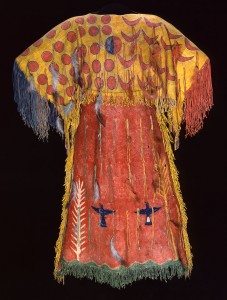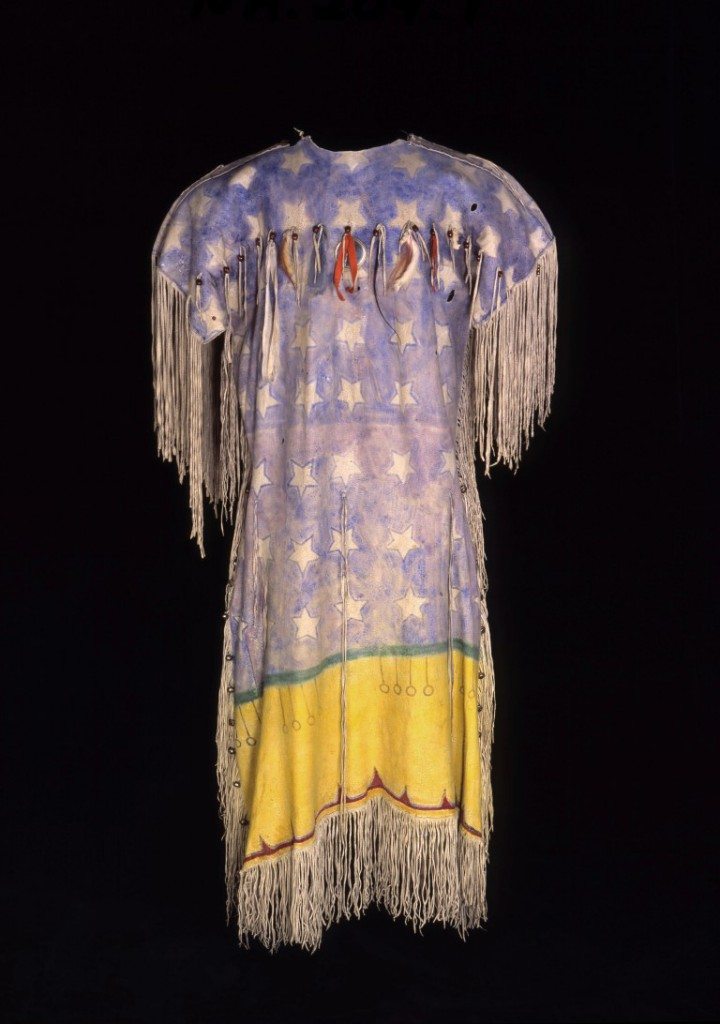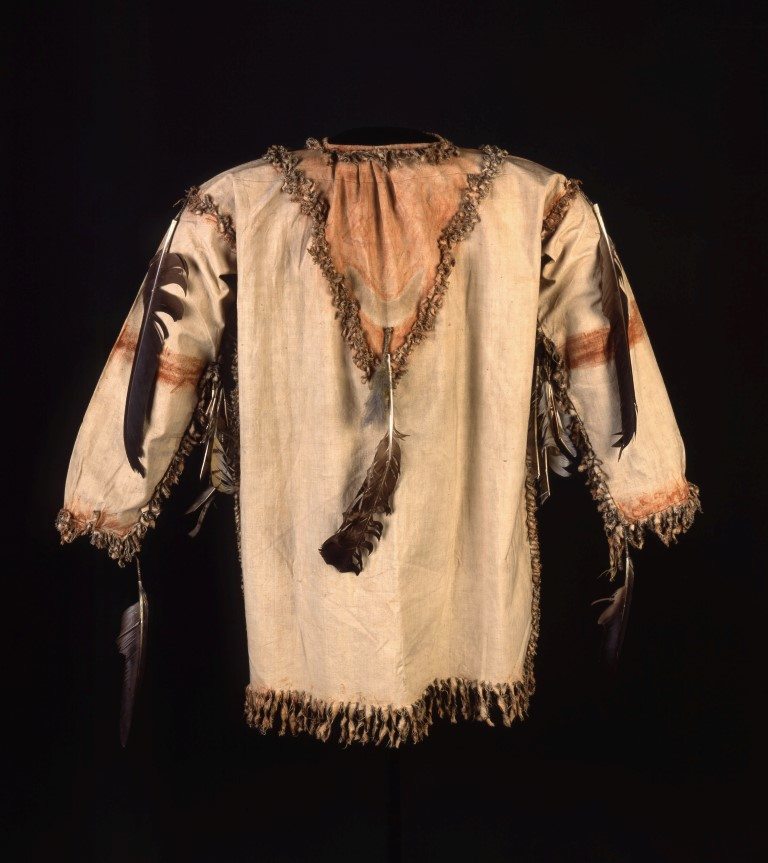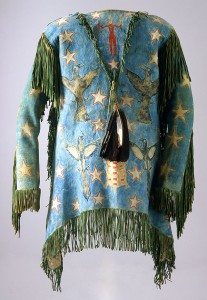Many of the American Indian tribes that participated in the Ghost Dances in the late 1800s created special shirts and dresses for that purpose and infused them with meaning and power.
In “Identity by Design: Tradition, Change, and Celebration in Native Women’s Dresses,” Colleen Cutschall wrote:
“Both buckskin and cloth Ghost Dance dresses were painted with highly charged symbols of nature and the elements and emblems of feminine identity.”

Those symbols include the thunderbird and new moon — which “speak to a hoped-for reversal of desperate conditions and the beginning of a new life” — the sacred pipe, holy cedar tree, morning star and turtle, which represents protection of women and long life.
The Buffalo Bill Center of the West’s website notes that the symbols on shirts and dresses include messengers to the heavens in the form of crows, eagles and magpies.
According to Cutschall:
“Through painted signs of power, the universe was being called upon to rescue [the Indians] from cultural genocide. When this new movement was unable to fulfill the promise of restored land, animals and deceased relatives, it dissolved. Dressmakers returned to time-honored quill and bead decoration. The short-lived explosion of new painted dress designs ended, never to be revived.”
But Peter Nabokov in “The Native Americans: An Illustrated History” wrote that revitalization movements like the Ghost Dance still survive. And others say the dance was performed during the American Indian Movement’s occupation of Wounded Knee in 1973, to honor the ancestors who had died there.
 The Denver Art Museum’s website says a pair of painted and beaded moccasins in its collection were created by a Southern Cheyenne artist for use in the Ghost Dance and later embellished by a Kiowa artist, who added beads:
The Denver Art Museum’s website says a pair of painted and beaded moccasins in its collection were created by a Southern Cheyenne artist for use in the Ghost Dance and later embellished by a Kiowa artist, who added beads:
“The Kiowa also danced the Ghost Dance during the same two-year span [1889-1890], but later brought it back in a different form and danced a revised version from 1894 to 1916.”
The Ghost Dance movement among the Plains Indian tribes was not the first of its kind. Twenty years earlier, tribes in north-central California were seeing their way of life destroyed by the influx of white settlers, who brought mining, ranching and deadly diseases. American Indian spiritual leaders “began preaching apocalyptic messages of redemption,” Nabokov wrote.
Around the same time, Smohalla, a Wanapum spiritual leader in Washington Territory, founded the Dreamer religion and advocated a spiritual uprising based on the rejection of farming and white man’s wares.

And in 1881, Apache medicine man Noch-ay-del-klinne held dances and promised better days for his people. His message was much the same as the Plains Indians’ Ghost Dance religion: Whites would disappear and slain chiefs would rise from the dead. When the Army tried to arrest him for being a troublemaker, fighting broke out between the soldiers and his followers, with the Army’s Apache scouts siding with their tribesmen. Noch-ay-del-klinne was killed in the crossfire.
Many of the beautiful Ghost Dance shirts and dresses were scattered in the immediate aftermath of the massacre at Wounded Knee. In “The West: An Illustrated History,” a nurse who tended to the survivors was quoted as saying:
“A young girl…who had a ghost shirt on underneath her clothes [said,] ‘They told me if I put this on the bullets would not go through and I believed them. Now see where we are.’”
The girl asked the nurse to get rid of the shirt.
According to an article by Mark Hirsch, on the battlefield:
“Looters quickly stripped the bodies of Ghost Dance shirts and other possessions, which were sold to collectors and museums. Photographers canvassed the corpse-ridden fields, and sold their photos as postcards. Advertisements said they were ‘just the thing to send to your friends back east.’”

Twenty-seven Ghost Dance leaders were initially imprisoned “then released into the custody of Buffalo Bill Cody, who featured them in his Wild West show. By agreeing to go on tour, the Ghost Dancers were spared lengthy prison terms,” Hirsch wrote.
However, in some respects, the power of Ghost Dance clothing never waned. In 1892, a museum in Glasgow, Scotland, acquired a Ghost Dance shirt from a member of Buffalo Bill’s show. More than 100 years later, in 1999, the shirt was returned to the Lakota tribe in a special ceremony. At the time, Marcella LeBeau, a member of the Cheyenne River Sioux tribe, said, “This will bring about a sense of closure to a sad and horrible event. Now healing can begin.”
Footnote: I read a book as a child about the Ghost Dance and Indian agent James McLaughlin’s efforts to stifle it. The book was geared toward young readers and spared them none of the tragedy of the situation. It made an indelible impression on me, and I still remember puzzling over how to pronounce McLaughlin’s unfamiliar name — it had “laugh” in it, yet there was no humor or lightness to the story or the man. (I think the book might have been Barbara Bonham’s “The Battle of Wounded Knee: The Ghost Dance Uprising,” published in 1970.)
Photos are of Ghost Dance shirts and dresses at the Buffalo Bill Center of the West.
1 thought on “The Beauty and Meaning of Ghost Dance Shirts”